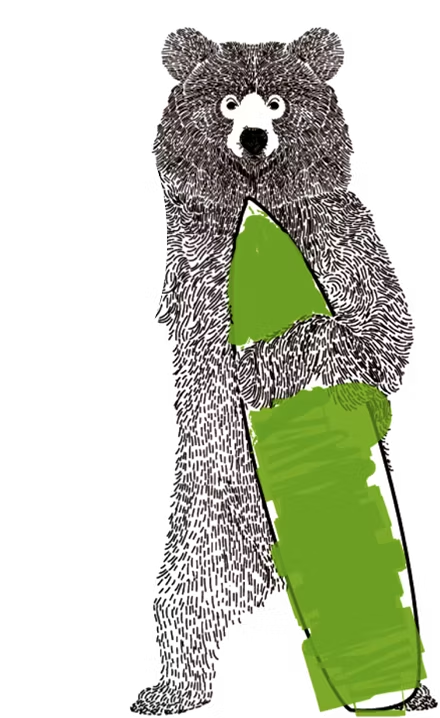Reposting beautiful illustrations, inspiring quotes, and funny doodles on social media has become ingrained in our online habits—it’s a new era of digital sharing, and we’re still kinda figuring things out. But there are certainly a few fundamental things to take into consideration before sharing the next illustration that makes you feel, “it me”.
In many cases, these viral gems are original creative works by an artist—an illustrator or graphic designer who has decided to bless us by posting their work online. Artists share their own work as a means of growing their business, to build their portfolio or online presence—of course they want to attract fans and customers who might purchase from their store, hire them for a project, or recommend them to others.
But what often happens is that the original creator’s Instagram handle gets cut off in the process of reposting, or their image is simply uploaded to Twitter without any credit, shared without any trace back to where it came from. There are consequences to this which can affect a designer’s livelihood. So it’s important for all of us to know how to share creative work properly online, whether we want to repost something to a personal channel, or a brand social account. I reached out to artist and author Adam J. Kurtz to learn more and put together this deep dive on how to do it right.
Meet Adam J. Kurtz, an artist and author whose work often goes viral—often without credit
Adam recently published a vlog about his experience of finding his work posted to a company’s social media channel, without his permission or credit. Adam’s first step was to contact the company directly first, asking for the post to be deleted. He received an apology, and was promised that it wouldn’t happen again, however it totally did happen again with the same company. So Adam decided the next step was to request a payment for a ‘retroactive social media license’ for the use of his work—he invoiced the company and was successfully paid. Adam’s vlog is a great explainer on how to share creative work properly online, whether for personal or work use:
When I first saw Adam’s video I was instantly struck by how well he addressed this new aspect of digital sharing. “I don’t think many of us can exist without sharing our work online”, Adam told me by email, when I asked him about being a very shareable creative in the digital age. “Whether it’s a creative studio portfolio showcase, or individual creatives sharing new work, process, daily warm-ups, or other bits and pieces. It’s how we build our brands, find new fans, and get more clients. This is how the business mostly works now. It can be scary enough to share your work with an audience when you’re worried they might not like it,” Adam explained.
Adam makes a living from his creative work—he’s designed products for the likes of Fish’s Eddy, Urban Outfitters, Tattly, and some of his other clients are Adobe, Instagram, The New York Times, Penguin Random House, Pepsi. Adam’s products, his writing and graphics tap into universal themes that resonate deeply (and are super fun)—it’s understandable that many people connect with what he does and that his work often goes viral.
While an artist can choose to share their work online to build their own following and establish a presence online—Adam for example has built a following of nearly 200,000 followers on his Instagram account—we need to be more aware of the best way to share designs when it’s created by someone else, whether it’s on our personal account, or when sharing something for a business.
What are the best practices when sharing creative work online?
Of course if you find something funny or touching, you want to share it with your followers—and there are soooooo many social sharing buttons which make this super easy. But this also makes it easy to accidentally or otherwise cut off the original creator’s handle. When people repost artist’s work to a personal network, this is no doubt a very beneficial action for artists, but you still want to just check quickly that you’ve credited the work properly.
Adam’s tip: When sharing to your personal account, tag the creator in both the image and caption, don’t alter the image, or edit out the creator’s handle or watermark.
Here are some best practises based on Adam’s suggestions, that we encourage everyone (whether for personal or biz use) to consider when sharing creative work—that could be a cartoon, illustration, quote, photo or other image. It’s super helpful advice that can generally be applied to all creative work:
- Check that the artist’s credit is not buried under a long comment and paragraph of hashtags. Be mindful of tagging the artist in the first couple of lines underneath the post.
- Feature the artist: Is the work being shared because it’s going viral and you want to get in on that, or to showcase the artist? In Adam’s case, he is only ok with brands sharing his work if the point is to showcase the work itself.
- Communicate: Brands should not share work without a credit or if the image has been altered. A partnership should not be implied, and the post shouldn’t advertise a sale or promotion if there isn’t one. If you want to set up a partnership with a designer based off an example of their work you like, reach out!
Some of this is common sense, but it’s always good to remind ourselves that there are living, breathing humans behind these designs whose livelihood depends on being properly credited for their work. Why do they post it online if they don’t want us to share it, you ask? Good question! The point is, artists are quite happy for you to share their work—the right way, and with a proper credit. And if you’re a brand using someone’s creative work to build your following online, there should be compensation involved for the artist.
I don’t want to scare you from sharing your favourite artist’s work, just be careful about how you share it. Creative people are tired of being told that the ‘exposure’ will be great—if it’s for personal use, a credit can go a long way to bringing new fans (and possible buyers) to a designer’s website. If you’re a brand, unless you’re showcasing the artist’s work only, there’s a responsibility to pay the artist for using their creative work—bills can’t be paid with exposure.
Tips for creators: what to do when you find your work shared without credit
Adam also pointed out to me that the risk for artists these days is not only if the work will be received well, but if it might take on a life of its own without any connection back to the artist, spiralling off into the digital sphere across the umpteen platforms we’re all constantly updating, streaming and scrolling through.
“Now you have to be kind of worried that they will [like it], and might help themselves to it for any number of reasons,” Adam explained. “My perspective is kind of the same for both—make your work and share it. If people don’t like it, they keep on scrolling. If one bad apple out there does repost or otherwise use your work unfairly, you can deal with it then.”
For designers who might be hesitant about sharing their work online, Adam feels that the positive results outweigh the possible risk. “If you don’t share, nobody can ever see anything,” he says. “That is worse than any other negative outcomes. We can’t worry about what we can’t control, so try to let go of those concerns until they become relevant. That’s just good life advice in general, really.”
If you’re a designer and you find that someone has posted your work without permission or without a credit, here are some tips for creatives that Adam shared with me.
- Ask accounts to update their caption: Adam says, “It sucks when it’s already been up for a while, so there’s not the same benefit of having your work seen and a possible influx of followers. But I have a keyboard “text replacement” shortcut on my phone now. With a few taps I can easily paste a little comment that basically says, “Hi thanks for sharing my work but please credit me in the caption so your followers can find my art and books.” It’s not written aggressively, and since I started doing it, most people have responded positively.
- Send a private email or direct message first: “There are plenty of people tweeting at big brands and seeing no retweets, no comments, and no response from the brand. So my approach is typically to be direct and discreet first. I DM the brand, email a listed address, or something like that. It keeps people from being on the defensive. And while I can’t really spend the time to educate everybody, it can make a difference later.”
Adam also told us how a proper credit can go a long way for an artist, if their work is featured and shared with a big audience:
- When ‘exposure’ is maybe okay but probably not legal: Adam says, “I’ve had one or two popular Instagram accounts […] share my work properly, with clear credit, to audiences of several million. That’s the kind of reposting that we’d all like, where a huge audience gets exposed to our work, and maybe 100+ new followers find us as a result. Reposting content might be questionably legal in the first place, but in the case of those big meme accounts, you can get your ‘payment’ in the form of that proper crediting.”
At the end of the day, if you’re a creative person who’s producing artwork, you should get to decide how that art is used.
- Remember, it’s your work—decide how you want your work to be shared: Adam says, “When it’s a company, you are in charge. You might not want a certain business using your art to promote their stuff. You can ask them to delete it, and if they really keep ignoring you, you actually can file a copyright claim through Instagram support. Your work has a value and if a brand hasn’t asked or paid for it first, then you can decide how to respond. It’s your work.”
So, what’s the best way to share my next favourite relatable #content?
In an ideal world everyone would stop and think, “Where did this come from?” before sharing the next pug cartoon or cute illustration which is going viral. When posting to your personal social media channels, make sure you credit the original artist properly with a visible tag, and if an artist has added their name at the bottom of an artwork, don’t cut it off if you’re using a tool which resizes an image (the work should really not be edited at all).
What to do if you’re not sure where an illustration came from? Try to trace it back from where you found it, or use Google reverse image search.
If you’re working for a brand and want to share original work to showcase an artist’s work, at least seek permission first with an explanation as to why you want to make the post, and make sure to add a link to their handle at the top of the description. If the post is being used to promote a business or build brand awareness, contact the artist first to discuss compensation—or commission something especially for you!
Finally, if you notice someone sharing original work without an artist credit, give them a polite heads up and encourage them to repost it with a correction. The artist will love you for it.




